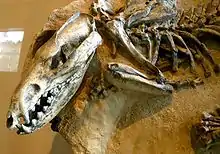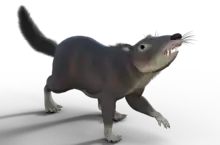Metatheria
Metatheria is a mammalian clade that includes all mammals more closely related to marsupials than to placentals. First proposed by Thomas Henry Huxley in 1880, it is a slightly more inclusive group than the marsupials; it contains all marsupials as well as many extinct non-marsupial relatives.
| Metatheria | |
|---|---|
 | |
| Lycopsis longirostris, an extinct sparassodont, a relative of the marsupials | |
| Scientific classification | |
| Kingdom: | Animalia |
| Phylum: | Chordata |
| Class: | Mammalia |
| Subclass: | Theria |
| Clade: | Metatheria Thomas Henry Huxley, 1880 |
| Subgroups | |
| |
There are three extant subclasses of mammals, one being metatherians:
- monotremes: egg laying mammals like the platypus and the echidna,
- metatheria: marsupials, which includes three American orders (Didelphimorphia, Paucituberculata and Microbiotheria) and four Australasian orders (Notoryctemorphia, Dasyuromorphia, Peramelemorphia and Diprotodontia),[4] and the
- eutherians: placental mammals, consisting of twenty-one orders, divided into four superorders.[5]
Metatherians belong to a subgroup of the northern tribosphenic mammal clade or Boreosphenida. They differ from all other mammals in certain morphologies like their dental formula, which includes about five upper and four lower incisors, a canine, three premolars, and four molars.[6] Other morphologies include skeletal and anterior dentition, such as wrist and ankle apomorphies; all metatherians share derived pedal characters and calcaneal features.
Classification
Below is a metatherian cladogram from Wilson et al. (2016):[7]
| Metatheria |
| ||||||||||||||||||||||||||||||||||||||||||||||||||||||||||||||||||||||||||||||||||||||||||||||||||||||||||||||||||||||||||||||||||||||||||||||||||||
Below is a listing of metatherians that do not fall readily into well-defined groups.
Basal Metatheria
- †Archaeonothos henkgodthelpi Beck 2015
- †Esteslestes ensis Novacek et al. 1991
- †Ghamidtherium dimaiensis Sánches-Villagra et al. 2007
- †Kasserinotherium tunisiense Crochet 1989
- †Palangania brandmayri Goin et al. 1998
- †Perrodelphys coquinense Goin et al. 1999
Ameridelphia incertae sedis:
- †Apistodon exiguus (Fox 1971) Davis 2007
- †Cocatherium lefipanum Goin et al. 2006
- †Dakotadens morrowi Eaton 1993
- †Iugomortiferum thoringtoni Cifelli 1990b
- †Marambiotherium glacialis Goin et al. 1999
- †Marmosopsis juradoi Paula Couto 1962 [Marmosopsini Kirsch & Palma 1995]
- †Pascualdelphys fierroensis
- †Progarzonia notostylopense Ameghino 1904
- †Protalphadon Cifelli 1990
Marsupialia incertae sedis:
- †Itaboraidelphys camposi Marshall & de Muizon 1984
- †Mizquedelphys pilpinensis Marshall & de Muizon 1988
- †Numbigilga ernielundeliusi Beck et al. 2008 {Numbigilgidae Beck et al. 2008}
Evolutionary history
The relationships between the three extant divisions of mammals (monotremes, marsupials, and placental mammals) was long a matter of debate among taxonomists.[8] Most morphological evidence comparing traits, such as the number and arrangement of teeth and the structure of the reproductive and waste elimination systems, favors a closer evolutionary relationship between marsupials and placental mammals than either has with the monotremes, as does most genetic and molecular evidence.[9]
Around the end of the Triassic period, a Therapsid developed traits or characteristics that are diagnostic of the class Mammalia. This class gave rise to Multituberculata (herbivorous mammals), Triconodonta and Symmetrodonta (carnivorous and insectivorous mammals). However, these are not seen after the end of the Early Cretaceous and by the Late Cretaceous marsupials and placentals had evolved from a common eupantotherian ancestor.[6] The Mammalia class probably saw its first eutherian in the early Cretaceous Jehol biota in China called Acristatherium yanesis. This eutherian was determined to be the most basal based on a phylogenetic analysis that used a data matrix of many other species.[10] Metatherians probably evolved to take advantage of open arboreal niches. Adaptive radiation of marsupials excluded competition with their terrestrial placental counterparts.
Fossil metatherians are distinguished from eutherians by the form of their teeth: metatherians possess four pairs of molar teeth in each jaw, whereas eutherian mammals (including true placentals) never have more than three pairs.[11] Using this criterion, the earliest known metatherian is Sinodelphys szalayi, which lived in China around 125 million years ago (mya). This 2003 study presents a new fossil from the early Cretaceous Yixian formation in China called Sinodelphys szalayi that gives enough morphological data to possibly be a basal metatherian in its didelphid-like morphology; it shares derived traits, such as dental formation and wrist and ankle structures. The fossil is about 125 million years old, making it one of the oldest metatherian fossils found and gives support to the claim that Asia was probably the center for diversification during the early Cretaceous. The researchers hypothesize that the divergence of Metatheria from Eutheria occurred in Asia no later than 125 million years ago, followed by the evolution of deltatheroidian-like taxa in Asia and North America about 120–100 million years ago and then the Paleocene diversification of relatives to the crown marsupials in South America.[12] This makes it a contemporary to some early eutherian species that have been found in the same area.[10] However, Bi et al. (2018) reinterpreted Sinodelphys as an early member of Eutheria.[3] They state that the oldest known metatherians are now the 110 million years old fossils from western North America.
The oldest metatherian fossils are found in present-day China.[13] About 100 mya, the supercontinent Pangaea was in the process of splitting into the northern continent Laurasia and the southern continent Gondwana, with what would become China and Australia already separated by the Tethys Ocean. From there, metatherians spread westward into modern North America (still attached to Eurasia), where the earliest true marsupials are found. It is difficult to identify which fossils are marsupials, as they are characterized by aspects of the reproductive system that do not normally fossilize (such as pouches) and by subtle changes in the bone and tooth structure that show a metatherian is part of the marsupial crown group (the most exclusive group that contains all living marsupials). The earliest definite marsupial fossil belongs to the species Peradectes minor, from the Paleocene of Montana, dated to about 65 million years ago.[1] From this point of origin in Laurasia, marsupials spread to South America, which was connected to North America until around 65 mya. Laurasian marsupials eventually died off; traditionally this has been assumed to be due to competition with placental mammals, but generally this is no longer considered to be the case, as metatherian diversity doesn't seem to be correlated to placental diversity.[14][15] Indeed, it appears metatherians suffered the heaviest mammalian casualties in the KT event, taking longer to recover than other groups.[16] In Laurasian landmasses, herpetotheriids and peradectids remained alive until the mid to late Miocene, with the peradectids Siamoperadectes and Sinoperadectes being the youngest Laurasian metatherians.
See also
- List of prehistoric mammals
- List of placental mammals (living species)
- List of monotremes and marsupials (living species)
References
- O'Leary, Maureen A.; Bloch, Jonathan I.; Flynn, John J.; Gaudin, Timothy J.; Giallombardo, Andres; Giannini, Norberto P.; Goldberg, Suzann L.; Kraatz, Brian P.; Luo, Zhe-Xi; Meng, Jin; Ni, Michael J.; Novacek, Fernando A.; Perini, Zachary S.; Randall, Guillermo; Rougier, Eric J.; Sargis, Mary T.; Silcox, Nancy b.; Simmons, Micelle; Spaulding, Paul M.; Velazco, Marcelo; Weksler, John r.; Wible, Andrea L.; Cirranello, A. L. (8 February 2013). "The Placental Mammal Ancestor and the Post–K-Pg Radiation of Placentals". Science. 339 (6120): 662–667. Bibcode:2013Sci...339..662O. doi:10.1126/science.1229237. hdl:11336/7302. PMID 23393258. S2CID 206544776.
- C.V. Bennett, P. Francisco, F. J. Goin, A. Goswami (2018). "Deep time diversity of metatherian mammals: implications for evolutionary history and fossil-record quality". Paleobiology. 44 (2): 171–198. doi:10.1017/pab.2017.34.CS1 maint: uses authors parameter (link)
- S. Bi, X. Zheng, X. Wang, N.E. Cignetti, S. Yang, J.S. Wible (2018). "An Early Cretaceous eutherian and the placental–marsupial dichotomy". Nature. 558 (7710): 390–395. Bibcode:2018Natur.558..390B. doi:10.1038/s41586-018-0210-3. PMID 29899454. S2CID 49183466.CS1 maint: uses authors parameter (link)
- Nilsson, Maria A. (2010). "Tracking Marsupial Evolution Using Archaic Genomic Retroposon Insertions". PLOS Biology. 8 (7): e1000436. doi:10.1371/journal.pbio.1000436. PMC 2910653. PMID 20668664.
- Wilson, Don E.; Reeder, DeeAnn M. (editors) (2005). Microtus (Mynomes) townsendii. Wilson and Reeder’s Mammal Species of the World — A Taxonomic and Geographic Reference (Print) (Third ed.). Baltimore, Maryland: Johns Hopkins University Press/Bucknell University. pp. 2, 142. ISBN 978-0-8018-8221-0. Retrieved 21 October 2014.CS1 maint: extra text: authors list (link)
- Szalay, Frederick S. (11 May 2006). Evolutionary History of the Marsupials and an Analysis of Osteological ... ISBN 9780521025928.
- Wilson, G.P.; Ekdale, E.G.; Hoganson, J.W.; Calede, J.J.; Linden, A.V. (2016). "A large carnivorous mammal from the Late Cretaceous and the North American origin of marsupials". Nature Communications. 7: 13734. Bibcode:2016NatCo...713734W. doi:10.1038/ncomms13734. PMC 5155139. PMID 27929063.
- Moyal, Ann Mozley (2004). Platypus: The Extraordinary Story of How a Curious Creature Baffled the World. Baltimore: The Johns Hopkins University Press. ISBN 978-0-8018-8052-0.
- van Rheede, T.; Bastiaans, T.; Boone, D.; Hedges, S.; De Jong, W.; Madsen, O. (2006). "The platypus is in its place: nuclear genes and indels confirm the sister group relation of monotremes and therians". Molecular Biology and Evolution. 23 (3): 587–597. doi:10.1093/molbev/msj064. PMID 16291999.
- Hu, Yaoming; Meng, Jin; Li, Chuankui; Wang, Yuanqing (2010). "New basal eutherian mammal from the Early Cretaceous Jehol biota, Liaoning, China". Proceedings of the Royal Society B. 277 (1679): 229–236. doi:10.1098/rspb.2009.0203. PMC 2842663. PMID 19419990.
- Benton, Michael J. (1997). Vertebrate Palaeontology. London: Chapman & Hall. p. 306. ISBN 978-0-412-73810-4.
- Rincon, Paul (12 December 2003). "Oldest Marsupial Ancestor Found, BBC, Dec 2003". BBC News. Retrieved 16 March 2010.
- Luo, Zhe-Xi; Ji, Qiang; Wible, John R.; Yuan, Chong-Xi (12 December 2003). "An early Cretaceous tribosphenic mammal and metatherian evolution". Science. 302 (5652): 1934–1940. Bibcode:2003Sci...302.1934L. doi:10.1126/science.1090718. PMID 14671295. S2CID 18032860.
- Sánchez-Villagra, Marcelo, Why are There Fewer Marsupials than Placentals? On the Relevance of Geography and Physiology to Evolutionary Patterns of Mammalian Diversity and Disparity, December 2013, Volume 20, Issue 4, pp 279–290
- Carter, AM; Mess, AM (2013). "Conservation of placentation during the tertiary radiation of mammals in South America". J Morphol. 274 (5): 557–69. doi:10.1002/jmor.20120. PMID 23355381. S2CID 24575630.
- Pires, Mathias M.; Rankin, Brian D.; Silvestro, Daniele; Quental, Tiago B. (1804). "Diversification dynamics of mammalian clades during the K–Pg mass extinction". Biology Letters. 14 (9): 2058. doi:10.1098/rsbl.2018.0458. PMC 6170748. PMID 30258031.
| Wikimedia Commons has media related to Metatheria. |










